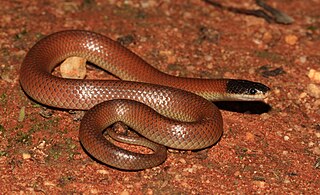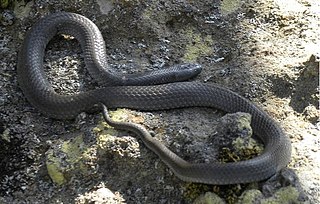
Charles Walter de Vis, known as Devis before about 1882, was an English zoologist, ornithologist, herpetologist, and botanist.

The common death adder is a species of death adder native to Australia. It is one of the most venomous land snakes in Australia and globally. While it remains widespread, it is facing increased threat from the ongoing Australian cane toad invasion.

The broad-headed snake is a species of venomous snake in the family Elapidae. The species is restricted to the Sydney Basin in New South Wales, Australia. It is one of three snakes in the genus Hoplocephalus, all restricted to eastern Australia. It is currently endangered in New South Wales and is listed as vulnerable under the Commonwealth Legislation.

Dwyer's snake also known commonly as the whip snake and the variable black-naped snake, is a species of venomous snake in the family Elapidae. The species is endemic to Australia, where it is found from New South Wales to South Queensland. While closely related to Australian sea snakes, S. dwyeri is a terrestrial reptile.

Denisonia is a genus of venomous snakes in the family Elapidae. The genus is endemic to Australia, and contains two recognized species.
The blue-bellied black snake, also known commonly as the spotted black snake, is a species of venomous snake in the family Elapidae. The species is native to Australia.

The highland copperhead, also known as Ramsay's copperhead, is a species of venomous snake in the family Elapidae endemic to Australia.
Hemiaspis damelii is a species of venomous snake in the family Elapidae. It is a relatively small species of elapid with a mean snout-vent length (SVL) of 42.6 to 60 cm. The species is endemic to eastern Australia and is most commonly found across central inland New South Wales through to the interior of south-eastern Queensland. Common names for this species include grey snake and Dämel's Snake. The specific name, damelii, is in honor of German entomologist Edward Dämel, who collected Australian specimens for Museum Godeffroy.

Cryptophis nigrescens is a species of venomous snake in the family Elapidae. The species is endemic to eastern Australia.

The red-naped snake is a small venomous reptile from the family Elapidae. The snakes are found in four Australian states and are listed as 'threatened' in Victoria'. They are nocturnal and feed on small skinks. The young eastern brown snake is similar in appearance.
Cacophis krefftii is a species of venomous snake in the family Elapidae. The species is endemic to Australia.

The ringed brown snake is a species of venomous elapid snake native to a broad swathe of inland Australia, from western New South Wales and Queensland to Western Australia.

The strap-snouted brown snake is a species of venomous snake in the family Elapidae. The species is native to South Australia, New South Wales, Queensland, and Victoria. P. aspidorhyncha is part of a species complex that also includes P. mengdeni and P. nuchalis; all were formerly included in the latter species.
The monk snake, also known commonly as the hooded snake, is a species of venomous snake in the family Elapidae. The species is native to central and western Australia.

The Mallee black-backed snake, also known commonly as the black-backed snake, the copper snake, and Mitchell's short-tailed snake, is a species of venomous snake in the family Elapidae. The species is endemic to Australia.

The little whip snake, also known commonly as the whip hooded snake, is a species of venomous snake in the family Elapidae. The species is endemic to Australia.

The spectacled hooded snake, also known commonly as the Port Lincoln snake, is a species of venomous snake in the family Elapidae. The species is native to central-southern Australia. There are three recognized subspecies.
Gould's hooded snake, also known commonly as the black-headed snake, is a species of venomous snake in the family Elapidae. The species is endemic to Western Australia.

Brachyurophis australis(coral snake) is a species of snake from the family Elapidae (common names - eastern shovel-nosed snake, coral snake, Australian coral snake) and is a species endemic to Australia. Its common name reflects its shovel nose specialisation.
Cryptophis boschmai, also known commonly as the Carpentaria snake or the Carpentaria whip snake, is a species of venomous snake in the family Elapidae. The species is native to Australia and New Guinea.
















